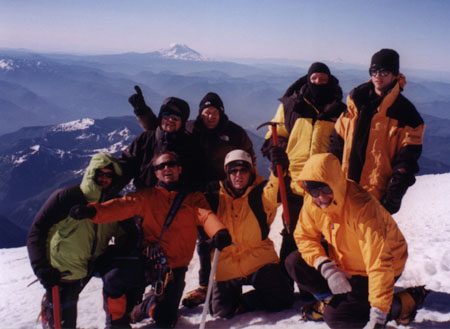
August 29, 2000 — From his airplane window, Milton Keller watched Atlanta’s nighttime lights fade into the dead black sky. He wondered if he’d ever see them again. And then he said a prayer.
It was early August. Keller and fellow Hall County firefighters Bryan Cash, Tyler Dorsey and Todd Folger were on their way to Washington state’s Mount Rainier, all 14,411 feet of it, the second-tallest mountain in the continental United States.
They planned on making it to the top.
The dangerous — sometimes deadly — climb was the culmination of months of training and years of planning for the foursome. They were filled with excitement, hesitation and, when they first set eyes on the imposing peak, a good bit of fear.
“It’s very intimidating,” said Folger.
And that was from a distance. That was before they even set foot on the glaciated mountain, “where everything else has the sense to stay away,” as Keller said. On Rainier, it’s not long before the mountain’s only living creatures are its climbers. They are brave or foolish, depending on whom you ask.
“Well, we’re kind of used to that,” Dorsey said. “Everything else is running out of a burning building, and we’re running in.”
No burning buildings on Rainier. But a deep crack in a glacier can kill you just as easily. They’re called crevasses. Some are three or four feet wide and need to be jumped across. At least one on this trip was 12 feet wide. The only way from one side to the other was a ladder laid over the opening.
“I don’t know how deep they were,” Dorsey said, “but you couldn’t see the bottom.”
“It’s hard to see the bottom when your eyes are closed anyway,” Keller added with a laugh.
The firefighters courted disaster numerous times during their 32-hour odyssey. All to stand on the top of a mountain.
Only about half of the 10,000 or so people who attempt to summit Rainier each year are successful, and the firefighters knew that when they signed on.
Leading the ascent was Sautee native Dan’l Windham, a professional guide on the mountain, who took a couple of days off to help out some friends from back home. They wouldn’t have made it without him.
The group left the Paradise Guide House at 9:45 a.m. August 2 to begin their climb from 5,400 feet. It was sunny, warm enough for shorts. Six hours and nearly 5,000 feet later they arrived at Camp Muir and were greeted by temperatures in the 40s and winds of 10 mph.
The mood was still upbeat. Everyone was talkative. But what lay ahead, in Dorsey’s words, was “the hardest thing I’ve ever done in my life.”
After Muir, things got serious. No more shorts, that’s for sure. Helmets, crampons and ice axes were musts. The entire hiking group was tied together by 30-foot ropes — if one member of the party were to fall, the others could dig their axes into the ice and stop him.
From then on, communication was difficult when it wasn’t impossible.
At 8 p.m., the group arrived at Ingraham Flats, where elevation is 11,200 feet and bodies receive roughly half the oxygen they do at sea level. Here they set up “camp” — they rolled their sleeping bags out in the snow and closed their eyes for a couple hours. A few of them actually got some sleep.
At 1 a.m., they attached headlamps to their helmets and began their final approach to the summit. It’s best to do the bulk of the hiking before the sun rises and thaws the snow. That’s when avalanches are most likely. The group heard seven of them during their adventure.
Steps were plodding and precise. They had to be. One section featured a 10-inch ledge of ice to walk on. On one side was a wall of ice, on the other a 300-foot drop. One foot in front of the other. One at a time.
Here’s where the rope becomes a hindrance, not a help.
“If one person falls,” Dorsey said, “everybody falls.”
Remember, they did this in the dark.
At 7:40 a.m., they arrived at High Break on Disappointment Cleaver, elevation 13,500 feet.
“People were having troubles,” Keller remembered.
The altitude was affecting the Georgia lowlanders. Statements became incoherent. One hiker, wanting tape to fix a boot, repeatedly asked for Gatorade instead.
Bodies were sore. Stomachs craved more than frozen Snickers bars and melted snow.
“I think all of us were to the point where if Dan’l had said, ‘Let’s go back,’ we would have gone back and not argued a bit,” Keller said.
But the group pressed on, and at 9 a.m. August 3 — nearly 24 hours after beginning the climb — they arrived at the summit. Exhausted. Ecstatic. Emotional.
“I had to choke back a tear or two,” Keller said.
“The first thing I wanted to do is call my wife,” Dorsey added.
So he did. Believe it or not, BellSouth cell phones work just fine on top of Mount Rainier.
Weather on the summit was not pleasant. Forty-mph winds made 20-degree temperatures feel even colder. So after 45 minutes of celebration and contemplation, it was time to go. Time for the eight-hour hike back to Paradise. That’s right, eight more hours.
“I was beginning to wonder if I was going to make it back to the bottom,” Dorsey said.
He did. They all did. And after their bodies healed, they left wanting more.
There’s something about mountains that makes humans want to climb them. And there’s something about the feeling you get on the top of a mountain that makes you want to do it again and again.
